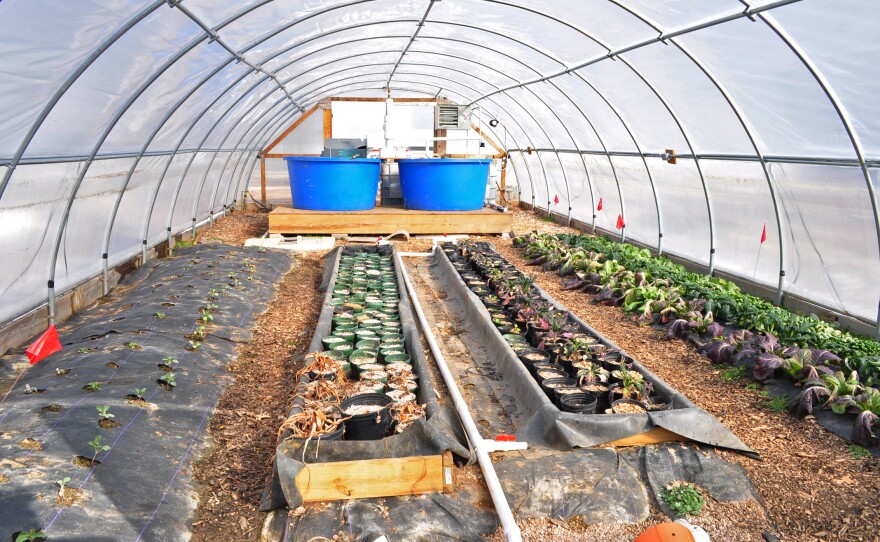
About 80 percent of Americans now live in urban areas, and more and more of us are growing food in cities as well.
But where's an urban farmer to turn for a soil test or when pests infiltrate the fruit orchard?
Increasingly, they can turn to institutions that have been serving farmers in rural areas for more than 150 years: land-grant colleges and universities. From Cornell University to the University of Florida to Texas A&M;, land grants dispense practical advice to farmers and hobby gardeners across the country.
The agricultural arms of these universities have historically focused regions far from cities where the majority of our food is still grown. But their research on crop varieties, soil quality and pest resistance is just as relevant — and now in high demand — inside the city.
Just ask Mchezaji "Che" Axum, who runs a research farm for the University of the District of Columbia, the only land-grant university in the country with an exclusively urban focus.
One of the central questions of urban agriculture is how to grow more food in less space. And so instead of vast fields testing dozens of varieties of wheat, Axum's research farm has raised beds, narrow hoop houses and even a shipping container. He gives growers advice on where to buy decent soil or how to compost their own, in case the land they plan to grow on has a seedy industrial past.
He says urban farmers aren't looking to grow one crop for a commodity market but enough crops to replace a trip to the grocery store or to fill a small farm box for customers. They need to know a little about a lot of varieties in order to make the most of small growing spaces. And, often, it's been a generation or two since anyone in their family has lived on a farm.
As interest in farming in the nation's capital has evolved, so has the 143-acre farm in Beltsville, Md. And it's serving as an example to other land-grants looking to cater to city farms.
"It's clear that urban settings, given how many people live there, still have an important role to play in food security and production," says Sabine O'Hara, director of UDC's land-grant programs. "So that's how we've positioned the farm."
The UDC farm serves as kind of a demonstration of the different ways agriculture can serve urban communities. There are apple orchards that supply area food pantries and shipping containers filled with fish that make food and fertilizer. The farm also has greenhouses filled with seedlings of specialty crops such as African eggplant and an omega-3-rich South American plant called waterleaf cultivated with immigrant communities in mind.
Axum, a trained agronomist, also has all kinds of research projects underway – looking at the nutrient density of crops and increasing their yield.
"They focus on some of the vital challenges of the urban setting: climate change, food security, hunger, obesity prevention," says Ahlishia Shipley, social science specialist with the U.S. Department of Agriculture's National Institute of Food and Agriculture, which helps fund land-grant programs.
But, she says, the urban extension's biggest challenge is getting the word out "that you're there to help."
In New York City, for example, Cornell University's Cooperative Extension has one staff member for every 160,000 residents, and tries to "make sure that all New York residents benefit from Cornell's research," says Jennifer Tiffany, executive director of the college's city-based outreach.
In New York, the Cornell extension office works alongside dozens of other organizations that add to its work by writing prescriptions for fruits and vegetables that can then be used at nearby farmers markets. Instead of visiting individual farms to offer growers advice, as staff might in a rural setting, Tiffany says her program leads instructional tours that take almost 100 people through an indoor hydroponics facility, showing them just how many calories of food can be grown inside the city buildings.
Though her university has been catering extension programs to the city's nearly 8.5 million residents for some time, other states are just beginning to see urban agriculture reach a critical mass. Texas A&M; University is gearing more of its land-grant programs toward the booming Dallas-Fort Worth region, where a farming workshop can draw as many as 4,000 people, Shipley says.
As other universities consider their urban audiences, they could take cues from the only land grant with an entirely urban charter.
Axum currently is experimenting with crops that specifically to meet nutritional needs of D.C. residents with HIV and AIDS. He works alongside local farmers to help them troubleshoot issues throughout the growing season, demonstrating nearly every growing practice they can imagine on the farm.
The farm also serves as home base to the land grant's chapter of the iconic Master Gardener Program, a national program that trains gardeners in all 50 states.
D.C. participants, Axum says, "have homes and yards and balconies and they want to learn to grow food. Then they become available as resources for other growers."
The Master Gardener Program has trained more than 400 D.C. residents since it was revitalized in 2002. Along with Axum, those urban gardening pros are ready and willing to share their expertise to beginners.
Whitney Pipkin is a freelance journalist writing about food, farms and the environment from Alexandria, Va. She also is staff writer for the Chesapeake Bay Journal and blogs at ThinkAboutEat.com.
Copyright 2015 NPR. To see more, visit http://www.npr.org/.






